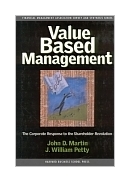|
||
• wydawnictwa polskie
• Zamów informacje o nowościach z wybranego tematu • kontakt
• Cookies na stronie |
VALUE BASED MANAGEMENTMARTIN J., PETTY W.wydawnictwo: HBS , rok wydania 2000, wydanie Icena netto: Value Based Management The Financial Management Association in conjunction with the Harvard Business School Press cosponsors the publication of the Survey and Synthesis Series in an effort to bridge the gap between financial research and the practice of finance. The subject of this book is value based management (VBM), which is the generic term for a set of management tools used to facilitate managing a firm's operations in a way that enhances shareholder value. VBM is a relatively recent innovation in financial practice that has only recently begun affecting financial research. The purpose of this book is to provide a survey of the tools and practices of VBM in a way that will be useful to academics and business practitioners alike. In a sense VBM is itself a synthesis of multiple business disciplines and subjects. From finance VBM has adopted the goal of shareholder value creation along with the acceptance of the discounted cash flow valuation paradigm. From business strategy VBM has accepted the notion that value creation is a result of investing in market niches or opportunities where the firm has some comparative advantage over current and potential competitors. From accounting VBM has adopted the basic structure of the firm's accounting statements and modified them for its own purposes. And finally, from organizational behavior VBM has adopted the notion that "what you measure and reward gets done." Thus, the VBM system constitutes a measurement and reward system designed to encourage employees to focus their activities on the creation of shareholder value. The development of VBM actually hinges upon some fundamental principles that have long been a part of the world of academic finance. First, VBM adopts as a given that value creation depends on discounted cash flow valuation concepts. Second, VBM is built upon the belief that a firm's actions are of great interest to the investing public. Thus, the manager should assume the perspective of the firm's investors when deciding how best to run the business. Business practice has evolved along two avenues. Capital budgeting practice adopted the notion of discounted future cash flow valuation. However, performance evaluation of ongoing operations for most firms continues to be based on annual accounting measures such as earnings and earnings growth. The inconsistency between these performance measures and shareholder value creation has long been recognized, but applying forward-looking valuation approaches presents some very difficult problems. VBM systems purport to resolve these problems and have gained widespread following, for instance, a special issue of Fortune magazine every year ranks the greatest U.S. wealth creators, and the Wall Street Journal provides rankings based on total shareholder returns. Three principal methods are being used in value based management, corresponding for the most part to the particular managerial consulting firm that serves as its proponent:
Although frequently promoted as new developments, all three of these techniques rely on the basic theory that underlies the use of traditional discounted cash flow methods for evaluating new investment opportunities. This is not to say that VBM does not bring something new and needed to the table. VBM is a way to assess the success or failure of ongoing operations; that is, it provides management with a method for evaluating the performance of the firm's existing assets or assets-in-place, using the same standard that is used to evaluate new asset acquisitions (i.e., the anticipated contribution to share value). This distinction is important because up to 40 percent of a firm's assets are not subjected to any discounted cash flow evaluation before being acquired. Consequently, managers of these assets have never been held accountable in terms of value creation or lack of it. In addition, VBM provides a structure for connecting performance with compensation- a matter of primary importance if we want managers to have the incentive to act in the shareholders' interest. The growing interest in VBM can be largely attributed to the rising prominence of shareholder interests in the management and control of U.S. corporations. This increasing concern for shareholder interests can be directly traced to the dramatic rise in institutional share holdings of U.S. corporations over the last two decades.... 246pages Księgarnia nie działa. Nie odpowiadamy na pytania i nie realizujemy zamówien. Do odwolania !. |


